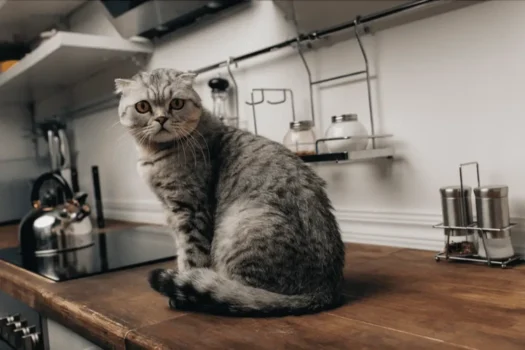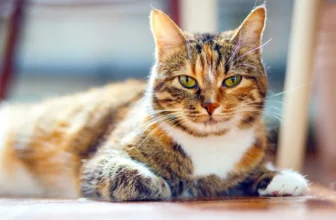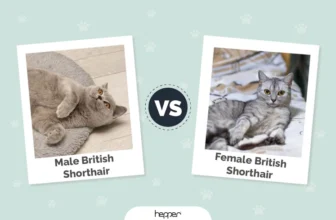Have you ever found your American Shorthair perched on your kitchen counter, observing your every move? If so, you’re not alone. Many cat owners struggle with the habit of their feline friends jumping on countertops and tables. While it might seem cute and harmless, allowing your cat to roam freely in areas where you prepare and eat food can lead to various problems. So, how do you break this habit? In this article, we’ll take a look at why cats jump on these surfaces and provide step-by-step instructions for training your cat to stay off them. Let’s get started!
Why Do Cats Jump on Countertops and Tables?
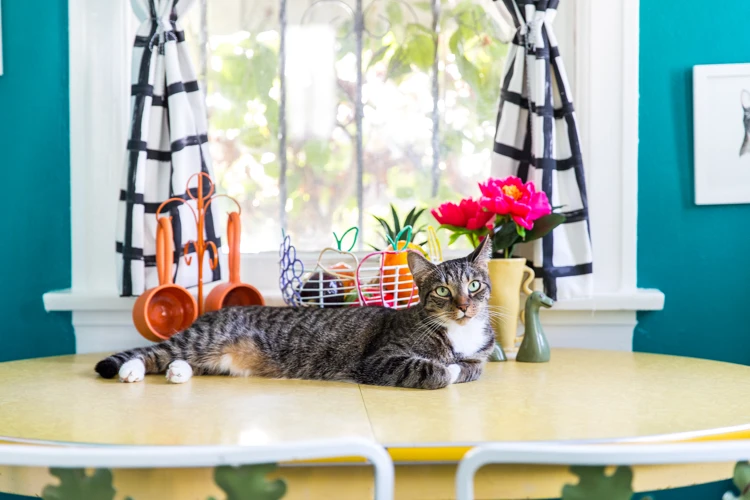
Have you ever walked into your kitchen and found your American Shorthair snooping around on your countertops or table? It can be perplexing to understand why cats have a fascination with elevated surfaces, especially when it’s one of the least desired habits of a feline. In this section, we’ll take a closer look at the reasons behind why cats have the tendency to jump onto countertops and tables, and what you can do to prevent it from happening again. So let’s explore the intriguing world of cats and their love for high places.
Curiosity
Cats are known for their curious nature. Curiosity is one of the primary reasons why American Shorthairs tend to explore and jump on countertops and tables even when they know they shouldn’t. American Shorthairs are naturally inquisitive and enjoy exploring their surroundings, especially high places where they can have an unobstructed view of everything around them.
- It is essential to understand that their need to climb and jump is deeply ingrained in their nature, and it can be challenging to eliminate altogether.
- However, there are ways to redirect this tendency towards more appropriate behavior.
- Preventing your cat from jumping on countertops and tables requires a good strategy that incorporates different techniques that work to discourage the behavior and encourage healthier habits instead.
To deter your American Shorthair from jumping on counters due to curiosity, try to provide them with an even more interesting environment. One way to do this is to create a cat-friendly area in your home that meets their natural need to climb and explore. You can set up cat trees or shelving units specifically designed for cats to jump and climb on. You can also provide toys, treats, and puzzle feeders to keep them entertained and mentally stimulated. Redirecting their curiosity to a designated space can inspire good behavior and discourage countertop and table jumping.
Opportunism
Opportunism is a natural trait in cats that can explain why they jump on countertops and tables. They’re constantly on the lookout for something that might interest them, and these surfaces offer a perfect vantage point from which to observe their surroundings. It’s important to note that your American Shorthair may not necessarily be looking for food or water when they jump on countertops or tables.
As natural predators, cats are attracted to movement and can easily become captivated by a dripping faucet or a running blender. In fact, some cats may jump on countertops and tables simply because they see something in motion and want to investigate. This can be particularly problematic if you’re preparing food or cooking on the stove.
To prevent this opportunistic behavior, it’s important to remove any potential triggers that might attract your cat’s attention. For example, if your cat is attracted to a dripping faucet, try to eliminate any excess water around the sink or invest in a pet fountain to provide them with a clean source of running water. Additionally, make sure to clean up any spills or crumbs as soon as they happen to prevent your cat from being attracted to the surface.
An effective way to keep your American Shorthair off countertops and tables is to provide them with alternative areas to perch and observe from. Consider installing some window perches or cat trees near windows to give them a designated space from which to survey their domain. You can also try using deterrents like double-sided tape or aluminum foil on the surfaces to make them unappealing to your cat.
Whatever method you choose to discourage countertop and table jumping, be consistent and reward positive behavior. With patience and persistence, you can teach your American Shorthair to stay off these surfaces and enjoy their own dedicated spaces.
Personal Space
Cats are territorial animals, and they can be quite possessive of their personal space. In fact, one of the biggest reasons why cats love to jump on countertops and tables is to claim these areas as their own.
To discourage your American Shorthair from jumping on countertops and tables due to their personal space needs, set up their personal spaces elsewhere in the house. You can create a special corner for your cat with a comfortable bed, toys, and scratching posts. Make sure that this area is accessible and comfortable for your cat, and regularly add new toys to keep it fresh and interesting.
Another way to give your American Shorthair their personal space is to create elevated spaces for them to perch on. You can install cat shelves on the walls or provide them with cat trees that they can climb and rest on. This will provide them with a high vantage point where they can observe their surroundings, which is one of the reasons why cats love to jump on counters and tables in the first place.
Pro Tip: If you notice your American Shorthair jumping on countertops and tables while you are cooking or eating, it could be a sign that they are feeling left out. Try to include your cat in your daily routines as much as possible, and give them treats and attention when they behave well.
| Useful Articles | Description |
|---|---|
| Stop American Shorthair from Scratching Furniture | Learn useful tips on how to stop your American Shorthair from scratching furniture. |
| Stop Your American Shorthair from Begging for Food | Learn how to discourage begging behavior in your American Shorthair. |
| Train Your American Shorthair for Playtime | Discover tips for training your American Shorthair for playtime to burn energy and reduce jumping behavior. |
| Tips to Discourage American Shorthair Marking Indoors | Find out how to prevent unwanted marking behavior in your American Shorthair. |
| How to Stop Your American Shorthair from Meowing | Learn how to understand and address excessive meowing in your American Shorthair. |
| Eliminating American Shorthair Night Crazies | Get tips for dealing with your American Shorthair’s nighttime zooming and playing. |
Why You Should Stop Your Cat from Jumping on Countertops and Tables

Cats are known for their curiosity and love of exploration, which often leads them to jump onto tables and countertops around the house. As adorable and harmless as this behavior may seem, it can actually be quite hazardous both to the health of your cat and to the health of your family.
Contamination Risks: Cats may walk and roam around outside or use their litter box before jumping on your kitchen surfaces. This increases the likelihood of carrying bacteria and germs onto your countertops and tables. If you frequently prepare or serve food on these surfaces, the contaminants can directly cause foodborne illnesses or other health issues.
Potential for Accidents: Kitchen countertops and tables often have sharp edges or heavy appliances that can cause injuries to your cat if they jump on them. In some cases, your cat may even knock over hot liquids or sharp tools, endangering both themselves and any humans nearby.
Scratching and Damage: Your cat’s claws can cause scratches and damage to your kitchen countertops and tables. This can impact the aesthetics of your kitchen, decrease the value of your home, and possibly even lead to costly repairs.
By training your cat to stay off of your countertops and tables, you’ll be providing a safer and healthier environment for both your cat and your family.
How to Train Your Cat to Stop Jumping on Countertops and Tables
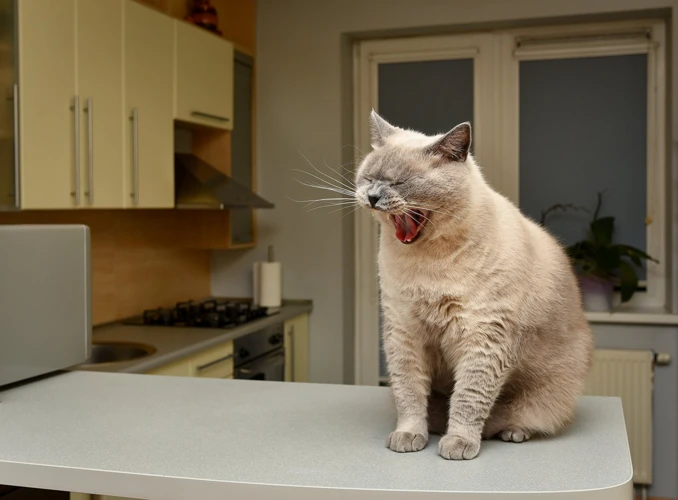
Are you tired of coming home to find your American Shorthair cat perched on your kitchen counter, licking the butter dish or walking over dirty dishes? While cats are naturally curious and agile, having them on kitchen surfaces can be a risk to their health and yours. Luckily, with patience and consistency, you can train your feline friend to refrain from jumping on countertops and tables. Let’s explore some effective methods that will help your cat understand boundaries and ensure that your kitchen remains a feline-free zone.
Set Up Safe and Comfortable Spaces
Creating safe and comfortable spaces for your American Shorthair cat is crucial in breaking their habit of jumping on countertops and tables. Here are some steps you can take to establish an ideal environment for your furry friend:
- Designate a cozy spot for your cat: Cats love having a designated space they can call their own. Purchase a soft bed or mat that your cat can sleep on while being close to you. This will help your cat feel secure, safe, and less likely to seek out elevated perches.
- Consider your cat’s age: If you have a senior cat, provide them with cat trees or low steps that help them to easily reach their favorite perches. On the other hand, if you have a kitten or young cat, invest in tall cat trees and window perches that allow them to burn off their energy. This redirecting of their energy to their designated space makes them less interested in your counter space.
- Position their space wisely: Position your cat’s bed or cat tree in a place that gives them a good view of their surroundings. Cats like to observe and feel incontrol in their surroundings and this can make them less interested in exploring elsewhere. Make sure the place you choose is far enough away from counters or tables to discourage jumping on them.
- Ensure easy accessibility: Ensure that your cat’s favorite sleeping or relaxing spot is at an easy reach of their paws, this will make them less likely to seek out elevated spaces like tables or countertops to rest on.
- Make it a fun and engaging space: Put catnip mouse toys and scratching posts in your cat’s designated space. This sets the space as a complete interactive environment for them and they won’t feel the need to explore and search for entertainment elsewhere. Reward them for using this space by giving them attention or treats, this provides a tangible incentive for them to utilize the space more often.
Creating a comfortable place that is unique to your American Shorthair and along making it an interactive and engaging space plays a crucial role in stopping cats from jumping on countertops and tables. Use these tips to establish a comprehensive and reliable environment for your feline friend that will make it less likely for them to jump on your counter tops and tables.
Provide Alternative Perches and Scratching Posts
Cats jump up high surfaces like countertops and tables because they enjoy being up high and they feel safe there. They also like to have a good vantage point to survey their surroundings. To prevent cats from jumping onto these surfaces, it is important to provide suitable alternatives for them. The Provide Alternative Perches and Scratching Posts technique is a good way to achieve this.
One way to provide alternative perches is by using cat trees or shelves. These areas can be placed in the kitchen or living room and provide a comfortable and safe place for cats to climb and observe their surroundings. Cat trees come in different sizes and shapes, so choose one that fits your cat’s size and suits your home decor.
Another option is cat shelves. Cat shelves are wall-mounted and are designed to provide your feline with a perch from which to view their surroundings from high up. You can also add carpeting to the shelf to provide your cat with a comfortable surface to lay on.
Cats also need a place to scratch, so providing scratching posts is essential to keep them off your furniture. Scratching posts come in various textures like carpet, sisal, and wood. Many cats prefer sisal or rough-textured surfaces, so consider purchasing a scratching post that incorporates those textures.
It’s important to remember that cats have individual preferences, so experiment with different types of perches and scratching posts. Observe which ones your cat prefers and place them in areas where they are most comfortable. By providing alternative perches and scratching posts, you are giving your cat their own personal space to feel safe and comfortable in your home.
| Alternative Perches | Scratching Posts |
|---|---|
| Cat trees | Carpeted Scratching posts |
| Cat shelves | Sisal-textured scratching posts |
| Window Perches | Wooden scratching posts |
Use Deterrents
When it comes to keeping cats off of countertops and tables, deterrents can be an effective tool. There are several options available to pet owners looking to discourage their feline friends from jumping on forbidden surfaces. Below are some ways to use deterrents:
| Deterrents | Details |
|---|---|
| Double-Sided Tape | Place double-sided tape on the surface of the countertop or table. Cats often dislike the sticky feeling on their paws and will learn to avoid the area. |
| Aluminum Foil | Place aluminum foil on the surface. Cats do not like the crinkly noise and may avoid the area. |
| Citrus | Cats dislike the smell of citrus, so spraying a citrus-scented spray on the surface can be effective. Alternatively, placing orange or lemon peels on the surface can also work as a deterrent. |
| Bitter Apple Spray | Bitter apple spray can be found at most pet stores and is safe for cats. Spraying it on the surface will make it taste unpleasant for cats and deter them from jumping up. |
| Motion-Activated Deterrents | There are motion-activated deterrents available that emit a loud noise or puff of air when triggered by a cat. These can be effective but may also startle other pets or people in the area. |
It’s important to note that while deterrents can be helpful, they should not be the only method used to stop cats from jumping on countertops and tables. Consistency and providing alternative spaces for your cat to climb and explore are also key factors in modifying their behavior. By using a combination of methods and being patient and persistent, pet owners can successfully train their cat to stay off of these surfaces and keep their kitchen cat-free.
Be Consistent and Reward Positive Behavior
Consistency is paramount when it comes to training your American Shorthair to stop jumping on counters and tables. Make sure everyone in the household is on the same page and consistently enforces the rules. Inconsistency will confuse the cat and make them less likely to learn.
Set clear boundaries: Clearly communicate to your cat where they are and aren’t allowed to go. Use a firm, but calm voice when enforcing these boundaries. It’s essential that everyone in the household follows the same rules; otherwise, your cat will become confused and won’t be able to learn.
Keep training sessions short and frequent: Cats have a short attention span, so it’s best to keep training sessions short (no more than 15 minutes) and frequent (2-3 times per day). This will help your furry friend retain the information and make it easier for them to learn.
Use positive reinforcement: Rewarding positive behavior is one of the most effective ways to train your American Shorthair. Whenever you catch your cat not jumping on the counter or table, give them a treat, praise them, or give them a good scratch behind the ears. Positive reinforcement is a proven method to facilitate learning by strengthening the behaviors you want to see.
Avoid punishment: Punishing your cat (e.g., yelling, spraying them with water, shocking them with static, or physical discipline) is never appropriate and will only scare and confuse them. Positive reinforcement is a better option, and it works much better to encourage and reward good behavior.
By consistently reinforcing positive behavior with rewards and attention, your American Shorthair will quickly learn that staying off the countertops and tables is the only way to get positive attention. Be patient and follow these simple guidelines, and your cat will be less likely to jump on your countertops and tables in no time.
Additional Tips for Keeping Your Kitchen Cat-Free
As a cat owner, keeping your kitchen cat-free can be challenging, but it’s necessary to maintain the cleanliness and safety of your food and cooking surfaces. Here are some additional tips to help keep your feline friend out of the kitchen:
Use Double-Sided Tape: Cats don’t like the sticky feeling of tape on their paws, so placing double-sided tape on your kitchen counters and tables can deter them from jumping up. Make sure to replace the tape regularly, as it can lose its stickiness over time.
Provide Adequate Playtime: If your cat is bored, they may turn to jumping on your countertops and tables for entertainment. Make sure your furry friend has plenty of toys and playtime to keep them occupied and reduce the temptation to climb on kitchen surfaces.
Install Motion-Activated Devices: You can install motion-activated devices, such as air cans or alarms, in areas where you don’t want your cat to go. These devices can startle your cat and encourage them to stay away from the kitchen.
Close the Door: If possible, close the door to your kitchen and restrict your cat’s access. This is especially helpful during meal prep or cooking, when your cat may be more interested in the smells and sights in the kitchen.
Seek Professional Help: If your cat continues to persistently jump on kitchen surfaces despite your efforts to discourage them, you may want to consider seeking advice from a professional animal behaviorist. They can provide additional training techniques and support to help break this habit.
By incorporating these tips with the techniques outlined above, you can successfully train your cat to stop jumping on countertops and tables in your kitchen, keeping them and your food safe.
Conclusion
After implementing the techniques outlined in this article, you should see a noticeable decrease in your American Shorthair’s habit of jumping on countertops and tables. It’s important to remember that this behavior is natural for cats and it may take some time to fully train them. Be patient and consistent in your approach.
Remember to prioritize your cat’s safety and comfort at all times. Avoid using harsh deterrents or punishing your cat for the behavior. Instead, provide alternative perches and scratching posts that meet their need for high places and vertical territory.
If you have multiple cats, it’s important to provide enough resources for each of them to prevent competition and aggression. Additionally, consider keeping your kitchen tidy and free of tempting food smells to reduce your cat’s motivation to jump on countertops and tables.
By taking a proactive approach and establishing clear boundaries with your cat, you can create a peaceful and enjoyable living space for both you and your feline friend. Don’t hesitate to seek advice from a veterinarian or animal behaviorist if you continue to struggle with this behavior or have any concerns about your cat’s health and well-being.
Frequently Asked Questions
How high can American Shorthairs jump?
American Shorthairs are known for their jumping abilities and can jump up to six times their body length vertically.
Can American Shorthairs learn to stay off countertops and tables?
Yes, with proper training and consistency, American Shorthairs can learn to stay off countertops and tables.
What are some safe spaces I can create for my cat?
You can create safe spaces for your cat by providing cat trees, window perches, or designated areas with comfortable bedding.
Can I still allow my cat on certain areas of the kitchen?
Yes, you can allow your cat on certain areas of the kitchen as long as they are not near food preparation areas and are trained to stay off countertops and tables.
Are there any types of deterrents I should avoid when training my cat?
Avoid using physical forms of punishment such as spraying water or hitting your cat as they can lead to trust and behavioral issues.
Should I reward my cat for not jumping on countertops and tables?
Yes, positive reinforcement in the form of treats, praise, and playtime can help reinforce good behavior and encourage your cat to continue to stay off countertops and tables.
How long does it take to train a cat to stay off countertops and tables?
The length of time it takes to train a cat to stay off countertops and tables depends on the individual cat and consistency of training, but it can take several weeks to several months.
What are some natural deterrents I can use to keep my cat off countertops and tables?
You can use natural deterrents such as citrus scents, double-sided tape, or aluminum foil on countertops and tables to discourage your cat from jumping on them.
Can training my cat to stay off countertops and tables improve their overall behavior?
Yes, training your cat to stay off countertops and tables can improve their overall behavior as it reinforces good behavior, establishes boundaries, and can reduce the likelihood of other unwanted behaviors such as scratching or chewing on furniture.
Is it cruel to keep my cat off countertops and tables?
No, keeping your cat off countertops and tables is not cruel as it is in the best interest of their safety and health. Additionally, there are plenty of other areas and options for your cat to perch and play.

